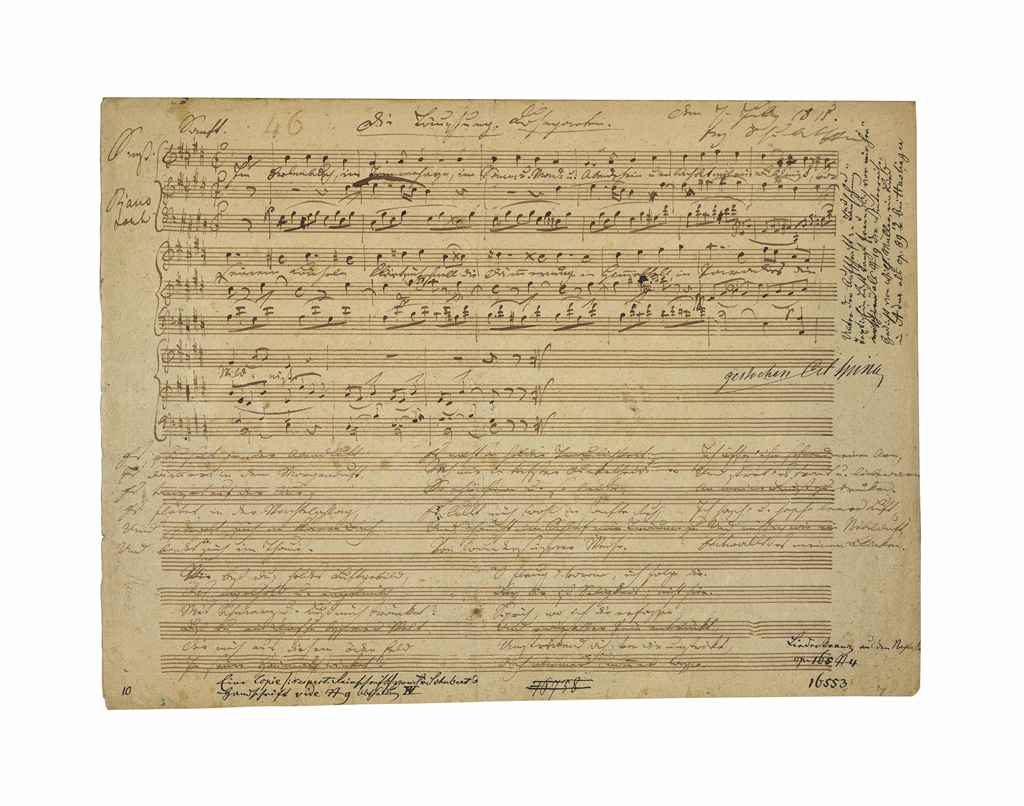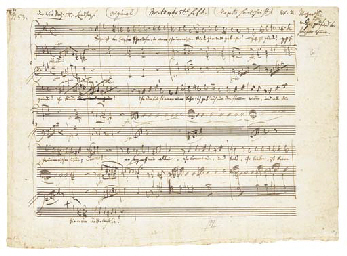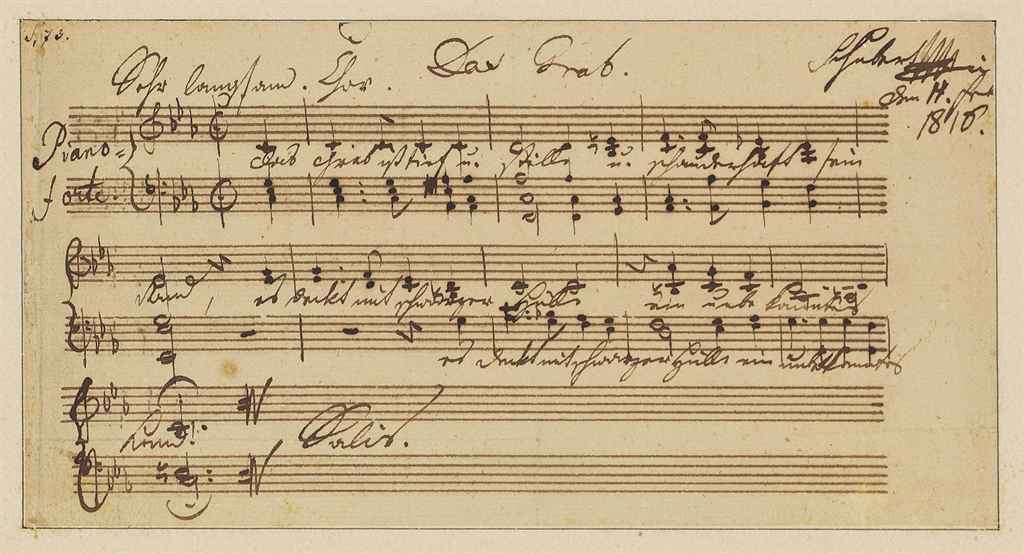AUTOGRAPH MUSIC MANUSCRIPT WITH THE FIRST LINE OF HIS POEM 'WHA IS THAT AT MY BOWER DOOR', 8 bars of autograph music, seven words of the lyric and the word 'Lively', with a further 4 bars of music at the top of the sheet, all in Burns's handwriting [two of his many contributions to Scots Musical Museum]; inscribed in another contemporary hand 'Witherspoons Vol 2d. page 111'; 16 bars of music on the verso not in Burns's handwriting; also with a nineteenth-century manuscript and printed extract from a catalogue (item 906) 'Lent by John Adamson' (mounted on card), 1 page, oblong small folio, 6 x 9 ¼ inches (from a larger sheet) [not dated, but 1787-1792] RARE: only one music manuscript by Burns has been sold at auction in the last forty years at least: a similar item to the present one, also formerly owned by John Adamson for the piece 'The German Lairdie' (Phillips, 11 June 1992, lot 71). John Adamson of Craigadam, Brookland, Crocketford, Dumfries, lent both the present manuscript (item 1025) [he had evidently lent it to another exhibition as item 906 - see above] and that of 'The German Lairdie' to the Burns Exhibition in 1896. At that memorial exhibition only one other similar item was shown: two lines of the music of 'Braes O' Mar' (item 1036 lent by James Stinton). Item 1283, 'Eleven sheets with scraps, songs and music and with the autograph of Burns on each sheet', was probably not related to Scots Musical Museum (lent by Mrs Dalziel - location unknown). AUTOGRAPH COPY FOR SCOTS MUSICAL MUSEUM, COMPLETE IN ITSELF (the first line, entire tune, and instruction by him), showing how Burns made his contributions to what is considered the most important collection of Scottish music and songs of all, having a pivotal role in the collecting of the music of Scotland. When James Johnson an Edinburgh music engraver, conceived the idea of publishing a comprehensive collection of Scottish songs which was to become the six-volume Scots Musical Museum, he enlisted the help of Burns who enthusiastically collected the work of others and provided over 200 songs of his own, including virtually all the poetry he wrote between 1787 and 1792. The first volume appeared in May 1787 and by the end of the year Burns had become the unacknowledged literary editor (he wrote the prefaces for volumes II-IV), with Stephen Clarke, 'the first musician in town', as the music editor. The reference written next to Burns's line of the lyric ('Witherspoons Vol. 2d. page 111') doubtless refers to David Herd's The Ancient and Modern Scottish Songs, published by Martin and Witherspoon, in 1769. It seems not improbable that this reference may well be written in the handwriting of Stephen Clarke, the musical editor. Although the idea had been Johnson's, Burns was the driving force behind the project. Just weeks before his death, Burns was writing encouragingly to Johnson and asking about the profits of the fifth volume (the last he would see completed). The present manuscript was illustrated by Catherine Carswell. Of Burns's own musical abilities and accomplishments, James Mackay has written: 'By addressing Sillar as a "brother fiddle" Robert implies that he had taken up the violin by this time [1783]. This is borne out by the reminiscences of Isobel Burns who said that, in emulation of his friend, Robert purchased an instrument for five shillings. When driven from the field by bad weather he would while away an idle hour with his fiddle. He never attained any proficiency on it, or the German flute which he subsequently attempted...Robert...could read music with reasonable fluency and even write musical notation.' Burns's 'vigorously impudent' poem 'Wha is that at my bower door' is thought to be one of the best examples in his work of 'man's somewhat brutal insistence and the woman's apparently refined coyness.' (Crawford). PROVENANCE: James Adamson of Craigadam, Dumfries; John Wilson REFERENCES: Memorial Catalogue of the Burns Exhibition held in the Galleries of
AUTOGRAPH MUSIC MANUSCRIPT WITH THE FIRST LINE OF HIS POEM 'WHA IS THAT AT MY BOWER DOOR', 8 bars of autograph music, seven words of the lyric and the word 'Lively', with a further 4 bars of music at the top of the sheet, all in Burns's handwriting [two of his many contributions to Scots Musical Museum]; inscribed in another contemporary hand 'Witherspoons Vol 2d. page 111'; 16 bars of music on the verso not in Burns's handwriting; also with a nineteenth-century manuscript and printed extract from a catalogue (item 906) 'Lent by John Adamson' (mounted on card), 1 page, oblong small folio, 6 x 9 ¼ inches (from a larger sheet) [not dated, but 1787-1792] RARE: only one music manuscript by Burns has been sold at auction in the last forty years at least: a similar item to the present one, also formerly owned by John Adamson for the piece 'The German Lairdie' (Phillips, 11 June 1992, lot 71). John Adamson of Craigadam, Brookland, Crocketford, Dumfries, lent both the present manuscript (item 1025) [he had evidently lent it to another exhibition as item 906 - see above] and that of 'The German Lairdie' to the Burns Exhibition in 1896. At that memorial exhibition only one other similar item was shown: two lines of the music of 'Braes O' Mar' (item 1036 lent by James Stinton). Item 1283, 'Eleven sheets with scraps, songs and music and with the autograph of Burns on each sheet', was probably not related to Scots Musical Museum (lent by Mrs Dalziel - location unknown). AUTOGRAPH COPY FOR SCOTS MUSICAL MUSEUM, COMPLETE IN ITSELF (the first line, entire tune, and instruction by him), showing how Burns made his contributions to what is considered the most important collection of Scottish music and songs of all, having a pivotal role in the collecting of the music of Scotland. When James Johnson an Edinburgh music engraver, conceived the idea of publishing a comprehensive collection of Scottish songs which was to become the six-volume Scots Musical Museum, he enlisted the help of Burns who enthusiastically collected the work of others and provided over 200 songs of his own, including virtually all the poetry he wrote between 1787 and 1792. The first volume appeared in May 1787 and by the end of the year Burns had become the unacknowledged literary editor (he wrote the prefaces for volumes II-IV), with Stephen Clarke, 'the first musician in town', as the music editor. The reference written next to Burns's line of the lyric ('Witherspoons Vol. 2d. page 111') doubtless refers to David Herd's The Ancient and Modern Scottish Songs, published by Martin and Witherspoon, in 1769. It seems not improbable that this reference may well be written in the handwriting of Stephen Clarke, the musical editor. Although the idea had been Johnson's, Burns was the driving force behind the project. Just weeks before his death, Burns was writing encouragingly to Johnson and asking about the profits of the fifth volume (the last he would see completed). The present manuscript was illustrated by Catherine Carswell. Of Burns's own musical abilities and accomplishments, James Mackay has written: 'By addressing Sillar as a "brother fiddle" Robert implies that he had taken up the violin by this time [1783]. This is borne out by the reminiscences of Isobel Burns who said that, in emulation of his friend, Robert purchased an instrument for five shillings. When driven from the field by bad weather he would while away an idle hour with his fiddle. He never attained any proficiency on it, or the German flute which he subsequently attempted...Robert...could read music with reasonable fluency and even write musical notation.' Burns's 'vigorously impudent' poem 'Wha is that at my bower door' is thought to be one of the best examples in his work of 'man's somewhat brutal insistence and the woman's apparently refined coyness.' (Crawford). PROVENANCE: James Adamson of Craigadam, Dumfries; John Wilson REFERENCES: Memorial Catalogue of the Burns Exhibition held in the Galleries of



.jpg)
.jpg)
.jpg)

.jpg)

.jpg)
.jpg)
.jpg)



Try LotSearch and its premium features for 7 days - without any costs!
Be notified automatically about new items in upcoming auctions.
Create an alert